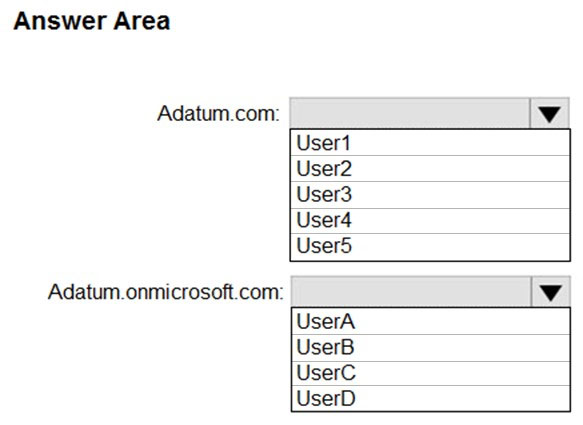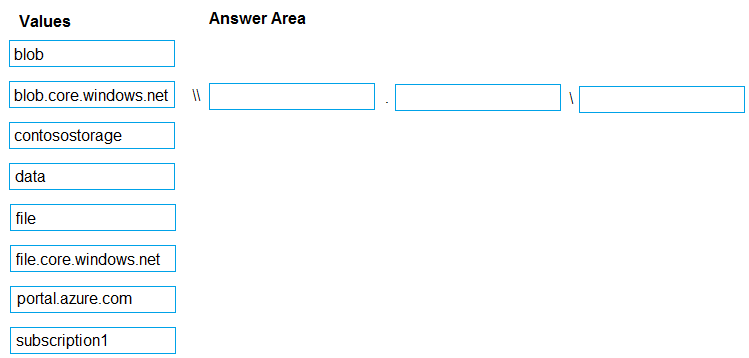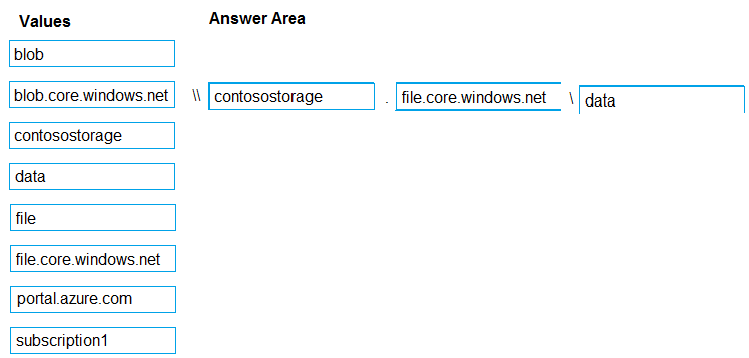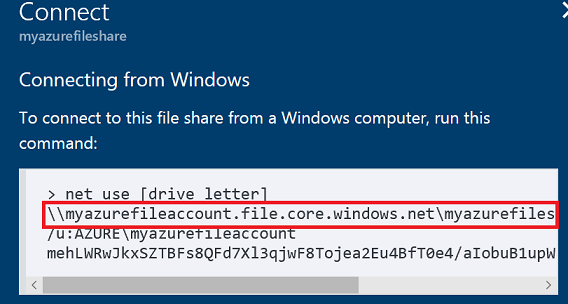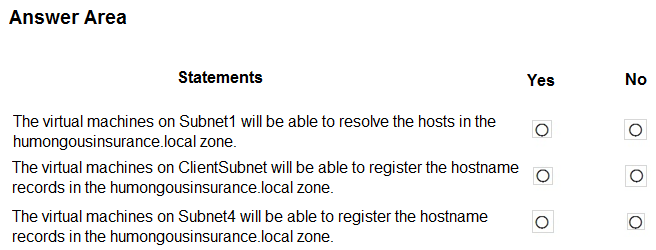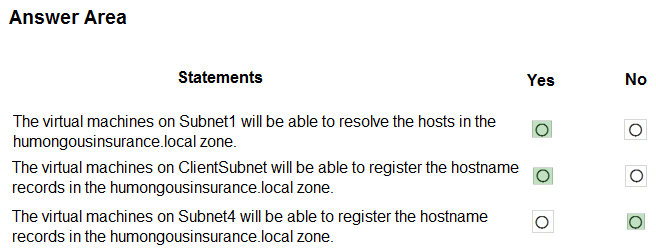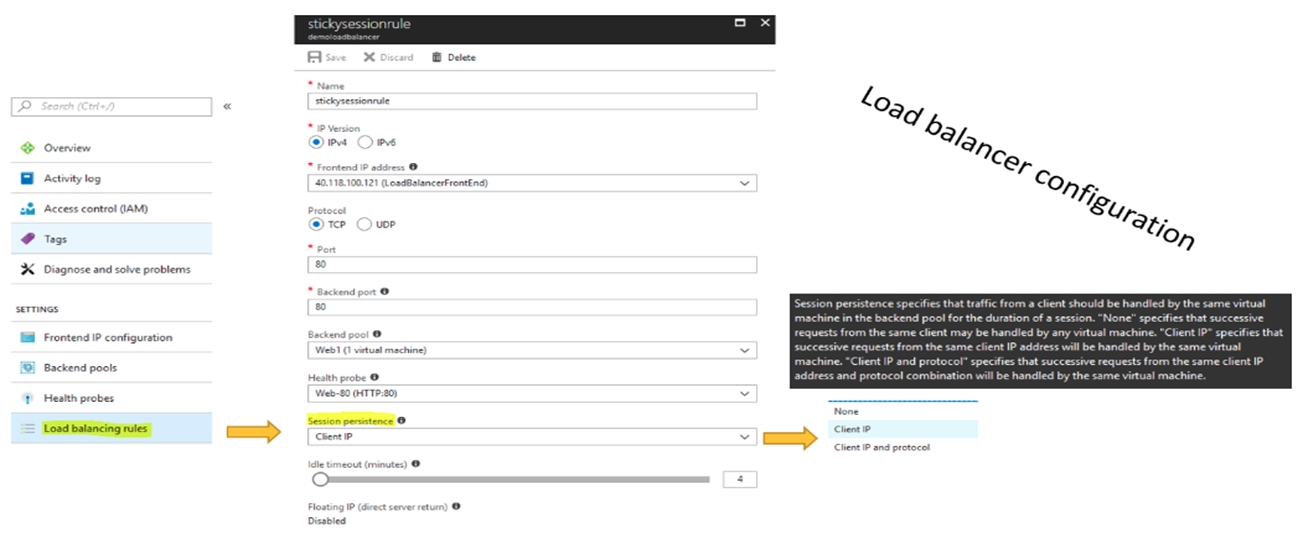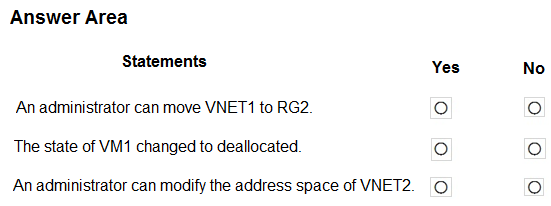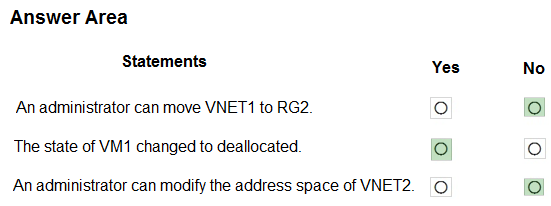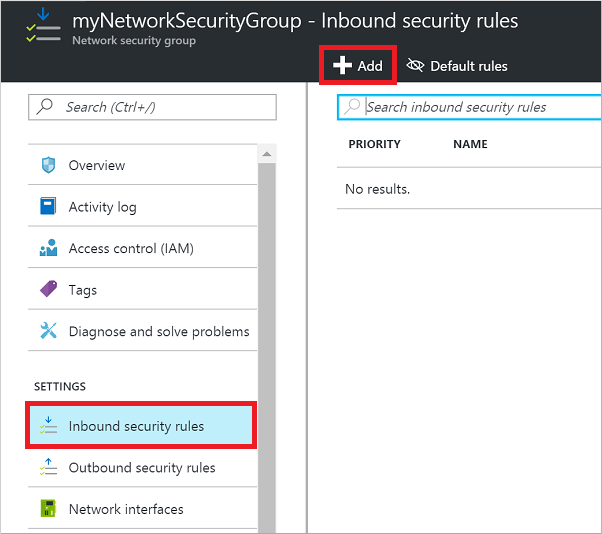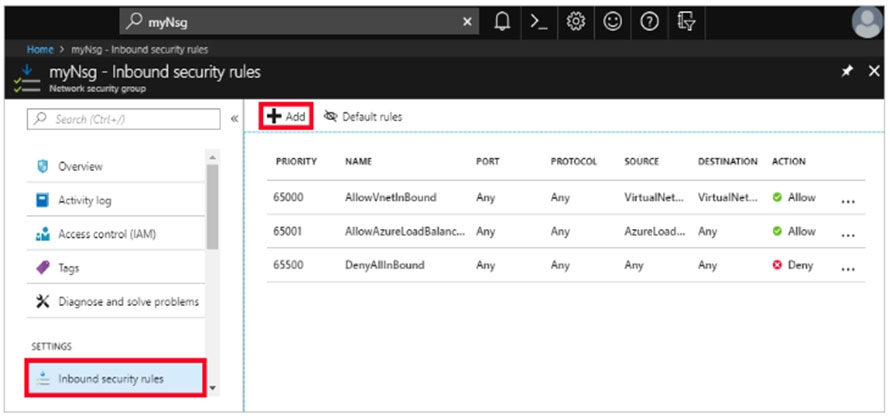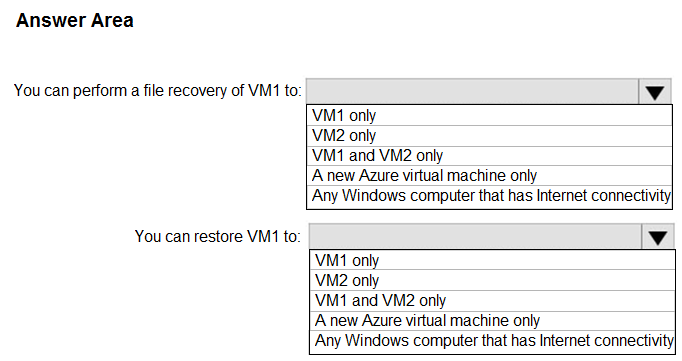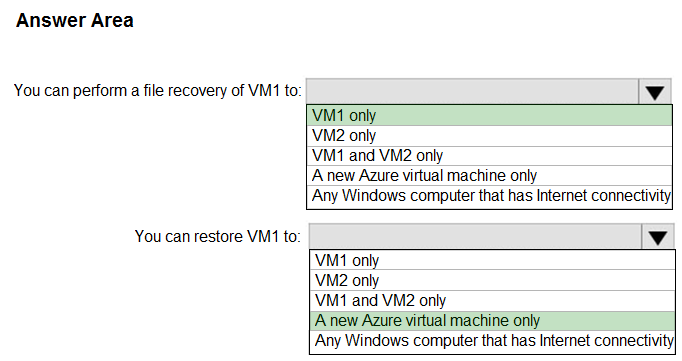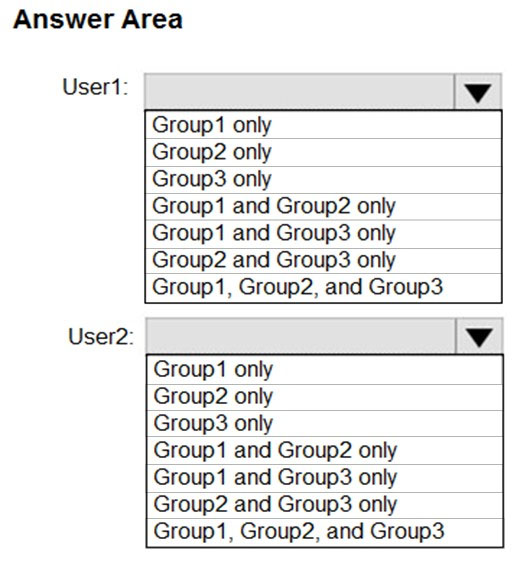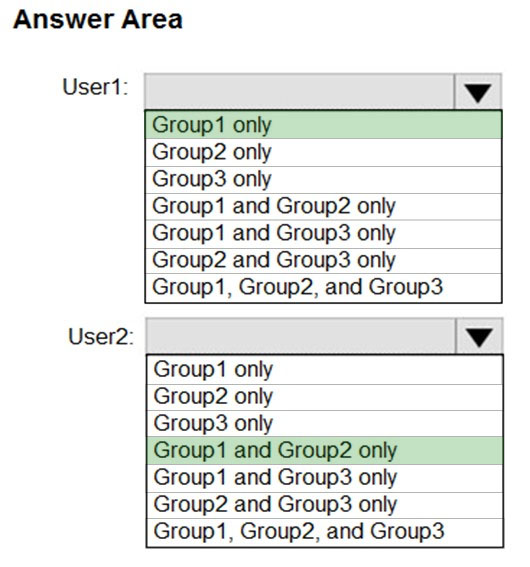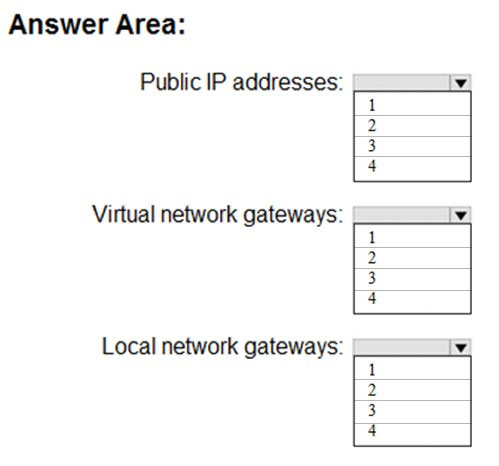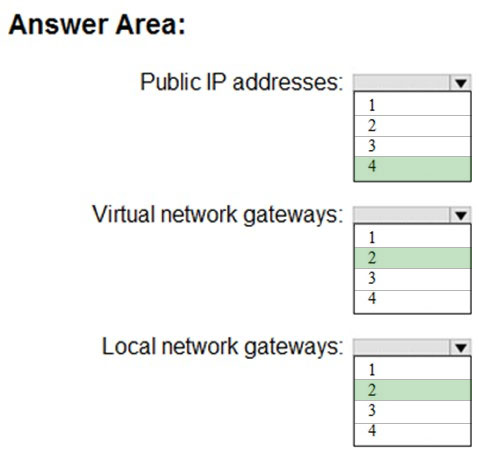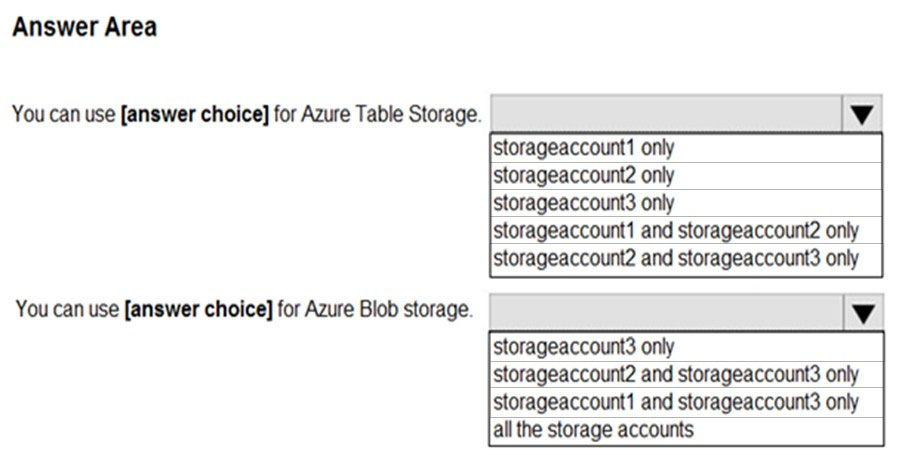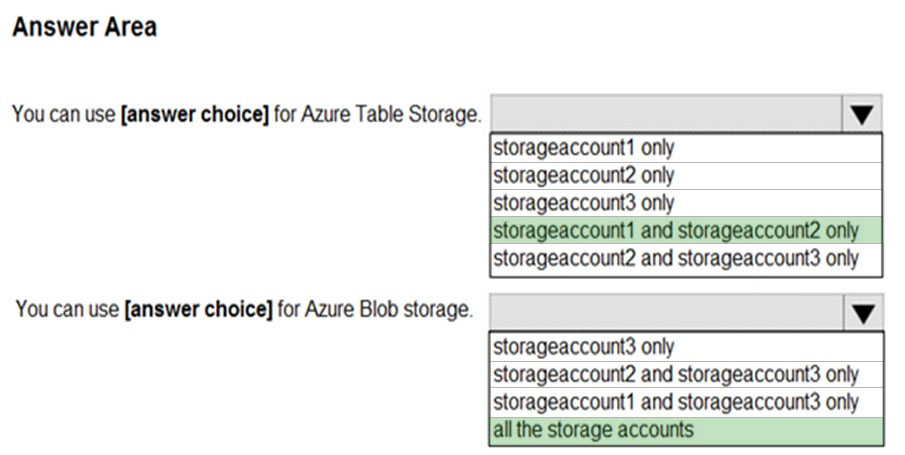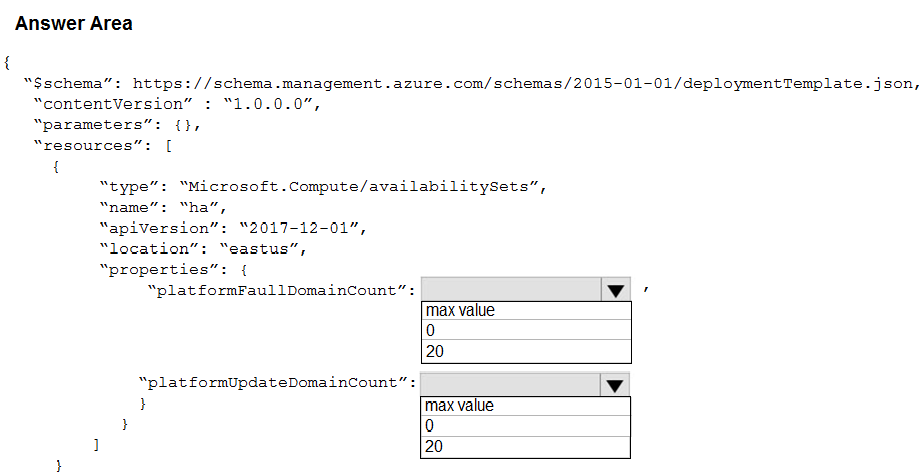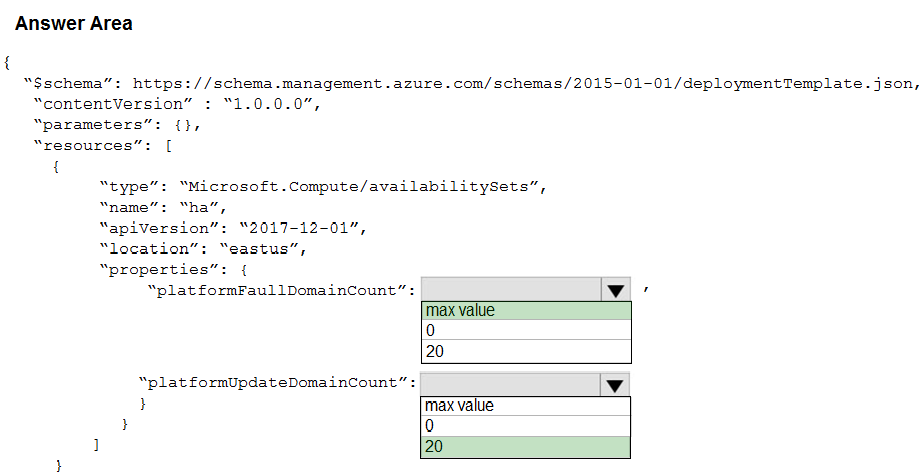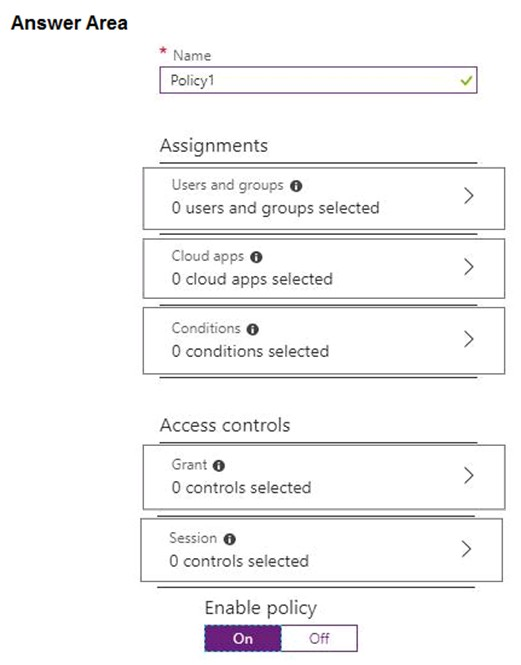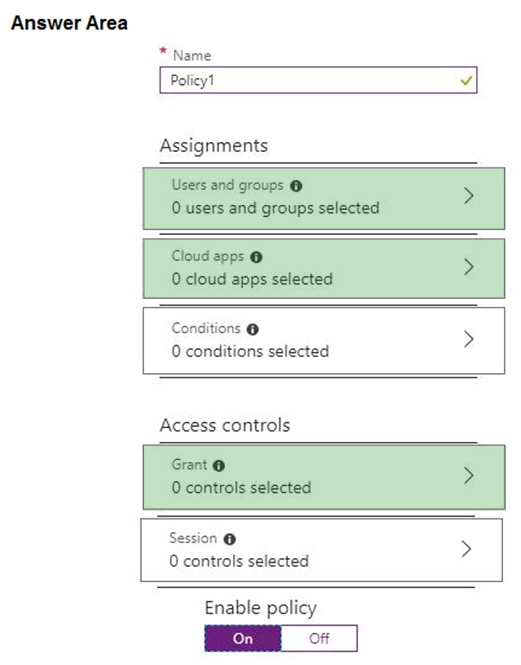AZ-103 Dump Free – 50 Practice Questions to Sharpen Your Exam Readiness.
Looking for a reliable way to prepare for your AZ-103 certification? Our AZ-103 Dump Free includes 50 exam-style practice questions designed to reflect real test scenarios—helping you study smarter and pass with confidence.
Using an AZ-103 dump free set of questions can give you an edge in your exam prep by helping you:
- Understand the format and types of questions you’ll face
- Pinpoint weak areas and focus your study efforts
- Boost your confidence with realistic question practice
Below, you will find 50 free questions from our AZ-103 Dump Free collection. These cover key topics and are structured to simulate the difficulty level of the real exam, making them a valuable tool for review or final prep.
You have the Azure virtual machines shown in the following table.You have a Recovery Services vault that protects VM1 and VM2. You need to protect VM3 and VM4 by using Recovery Services. What should you do first?
A. Create a new backup policy.
B. Configure the extensions for VM3 and VM4.
C. Create a storage account.
D. Create a new Recovery Services vault.
You have two Azure Active Directory (Azure AD) tenants named contoso.com and fabrikam.com. You have a Microsoft account that you use to sign in to both tenants. You need to configure the default sign-in tenant for the Azure portal. What should you do?
A. From Azure Cloud Shell, run Set-AzureRmSubscription.
B. From Azure Cloud Shell, run Set-AzureRmContext.
C. From the Azure portal, configure the portal settings.
D. From the Azure portal, change the directory.
You have an Azure virtual machine named VM1. The network interface for VM1 is configured as shown in the exhibit. (Click the Exhibit tab.)You deploy a web server on VM1, and then create a secure website that is accessible by using the HTTPS protocol. VM1 is used as a web server only. You need to ensure that users can connect to the website from the internet. What should you do?
A. Create a new inbound rule that allows TCP protocol 443 and configure the protocol to have a priority of 501.
B. For Rule5, change the Action to Allow and change the priority to 401.
C. Delete Rule1.
D. Modify the protocol of Rule4.
You need to resolve the licensing issue before you attempt to assign the license again. What should you do?
A. From the Groups blade, invite the user accounts to a new group.
B. From the Profile blade, modify the usage location.
C. From the Directory role blade, modify the directory role.
Your company has a main office in London that contains 100 client computers. Three years ago, you migrated to Azure Active Directory (Azure AD). The company's security policy states that all personal devices and corporate-owned devices must be registered or joined to Azure AD. A remote user named User1 is unable to join a personal device to Azure AD from a home network. You verify that other users can join their devices to Azure AD. You need to ensure that User1 can join the device to Azure AD. What should you do?
A. From the Device settings blade, modify the Users may join devices to Azure AD setting.
B. From the Device settings blade, modify the Maximum number of devices per user setting.
C. Create a point-to-site VPN from the home network of User1 to Azure.
D. Assign the User administrator role to User1.
After you answer a question in this section, you will NOT be able to return to it. As a result, these questions will not appear in the review screen. Your company registers a domain name of contoso.com. You create an Azure DNS zone named contoso.com, and then you add an A record to the zone for a host named www that has an IP address of 131.107.1.10. You discover that Internet hosts are unable to resolve www.contoso.com to the 131.107.1.10 IP address. You need to resolve the name resolution issue. Solution: You add an NS record to the contoso.com Azure DNS zone. Does this meet the goal?
A. Yes
B. No
You have an Azure subscription that contains three virtual networks named VNet1, VNet2, and VNet3. VNet2 contains a virtual appliance named VM2 that operates as a router. You are configuring the virtual networks in a hub and spoke topology that uses VNet2 as the hub network. You plan to configure peering between VNet1 and Vnet2 and between VNet2 and VNet3. You need to provide connectivity between VNet1 and VNet3 through VNet2. Which two configurations should you perform? Each correct answer presents part of the solution.
A. On the peering connections, use remote gateways.
B. On the peering connections, allow forwarded traffic.
C. On the peering connections, allow gateway transit.
D. Create route tables and assign the table to subnets.
E. Create a route filter.
HOTSPOT - Your network contains an Active Directory domain named adatum.com and an Azure Active Directory (Azure AD) tenant named adatum.onmicorosft.com. Adatum.com contains the user accounts in the following table.Adatum.onmicrosoft.com contains the user accounts in the following table.
You need to implement Azure AD Connect. The solution must follow the principle of least privilege. Which user accounts should you use? To answer, select the appropriate options in the answer area. NOTE: Each correct selection is worth one point. Hot Area:
DRAG DROP - You have an Azure subscription that contains a storage account. You have an on-premises server named Server1 that runs Windows Server 2016. Server1 has 2 TB of data. You need to transfer the data to the storage account by using the Azure Import/Export service. In which order should you perform the actions? To answer, move all actions from the list of actions to the answer area and arrange them in the correct order. NOTE: More than one order of answer choices is correct. You will receive credit for any of the correct orders you select. Select and Place:
You have an Azure subscription named Subscription1. Subscription1 contains a virtual machine named VM1. You have a computer named Computer1 that runs Windows 10. Computer1 is connected to the Internet. You add a network interface named Interface1 to VM1 as shown in the exhibit. (Click the Exhibit tab.)From Computer1, you attempt to connect to VM1 by using Remote Desktop, but the connection fails. You need to establish a Remote Desktop connection to VM1. What should you do first?
A. Change the priority of the RDP rule.
B. Attach a network interface.
C. Delete the DenyAllInBound rule.
D. Start VM1.
After you answer a question in this section, you will NOT be able to return to it. As a result, these questions will not appear in the review screen. You have an Azure subscription that contains the following resources: ✑ A virtual network that has a subnet named Subnet1 ✑ Two network security groups (NSGs) named NSG-VM1 and NSG-Subnet1 ✑ A virtual machine named VM1 that has the required Windows Server configurations to allow Remote Desktop connections NSG-Subnet1 has the default inbound security rules only. NSG-VM1 has the default inbound security rules and the following custom inbound security rule: ✑ Priority: 100 ✑ Source: Any ✑ Source port range: * ✑ Destination: * ✑ Destination port range: 3389 ✑ Protocol: UDP ✑ Action: Allow VM1 connects to Subnet1. NSG1-VM1 is associated to the network interface of VM1. NSG-Subnet1 is associated to Subnet1. You need to be able to establish Remote Desktop connections from the internet to VM1. Solution: You add an inbound security rule to NSG-Subnet1 and NSG-VM1 that allows connections from the internet source to the VirtualNetwork destination for port range 3389 and uses the TCP protocol. Does this meet the goal?
A. Yes
B. No
You have an Azure Active Directory (Azure AD) tenant named contosocloud.onmicrosoft.com. Your company has a public DNS zone for contoso.com. You add contoso.com as a custom domain name to Azure AD. You need to ensure that Azure can verify the domain name. Which type of DNS record should you create?
A. SRV
B. PTR
C. RRSIG
D. TXT
After you answer a question in this section, you will NOT be able to return to it. As a result, these questions will not appear in the review screen. You have an Azure Active Directory (Azure AD) tenant named Adatum and an Azure Subscription named Subscription1. Adatum contains a group named Developers. Subscription1 contains a resource group named Dev. You need to provide the Developers group with the ability to create Azure logic apps in the Dev resource group. Solution: On Subscription1, you assign the Logic App Operator role to the Developers group. Does this meet the goal?
A. Yes
B. No
You have an Azure Active Directory (Azure AD) tenant named contoso.onmicrosoft.com. You hire a temporary vendor. The vendor uses a Microsoft account that has a sign-in of user1@outlook.com . You need to ensure that the vendor can authenticate to the tenant by using user1@outlook.com . What should you do?
A. From the Azure portal, add a custom domain name, create a new Azure AD user, and then specify user1@outlook.com as the username.
B. From Azure Cloud Shell, run the New-AzureADUser cmdlet and specify the “”UserPrincipalName user1@outlook.com parameter.
C. From the Azure portal, add a new guest user, and then specify user1@outlook.com as the email address.
D. From Windows PowerShell, run the New-AzureADUser cmdlet and specify the “”UserPrincipalName user1@outlook.com parameter.
HOTSPOT - You have an Azure subscription named Subscription1 that contains a resource group named RG1. In RG1, you create an internal load balancer named LB1 and a public load balancer named LB2. You need to ensure that an administrator named Admin1 can manage LB1 and LB2. The solution must follow the principle of least privilege. Which role should you assign to Admin1 for each task? To answer, select the appropriate options in the answer area. NOTE: Each correct selection is worth one point. Hot Area:
DRAG DROP - You have an Azure subscription named Subscription1. You create an Azure Storage account named contosostorage, and then you create a file share named data. Which UNC path should you include in a script that references files from the data file share? To answer, drag the appropriate values to the correct targets. Each value may be used once, more than once, or not at all. You may need to drag the split bar between panes or scroll to view content. NOTE: Each correct selection is worth one point. Select and Place:
HOTSPOT - You are evaluating the name resolution for the virtual machines after the planned implementation of the Azure networking infrastructure. For each of the following statements, select Yes if the statement is true. Otherwise, select No. Hot Area:
You plan to use the Azure Import/Export service to copy files to a storage account. Which two files should you create before you prepare the drives for the import job? Each correct answer presents part of the solution. NOTE: Each correct selection is worth one point.
A. a driveset CSV file
B. a JSON configuration file
C. a PowerShell PS1 file
D. an XML manifest file
E. a dataset CSV file
You have an Azure subscription named Subscription1 and an on-premises deployment of Microsoft System Center Service Manager. Subscription1 contains a virtual machine named VM1. You need to ensure that an alert is set in Service Manager when the amount of available memory on VM1 is below 10 percent. What should you do first?
A. Create a notification.
B. Create an automation runbook.
C. Deploy the IT Service Management Connector (ITSM).
D. Deploy a function app.
You have five Azure virtual machines that run Windows Server 2016. The virtual machines are configured as web servers. You have an Azure load balancer named LB1 that provides load balancing services for the virtual machines. You need to ensure that visitors are serviced by the same web server for each request. What should you configure?
A. Idle Time-out (minutes) to 20
B. Floating IP (direct server return) to Disabled
C. Floating IP (direct server return) to Enabled
D. Session persistence to Client IP and protocol
E. a health probe
DRAG DROP - You need to prepare the environment to ensure that the web administrators can deploy the web apps as quickly as possible. Which three actions should you perform in sequence? To answer, move the appropriate actions from the list of actions to the answer area and arrange them in the correct order. Select and Place:
SIMULATION - Please wait while the virtual machine loads. Once loaded, you may proceed to the lab section. This may take a few minutes, and the wait time will not be deducted from your overall test time. When the Next button is available, click it to access the lab section. In this section, you will perform a set of tasks in a live environment. While most functionality will be available to you as it would be in a live environment, some functionality (e.g, copy and paste, ability to navigate to external websites) will not be possible by design. Scoring is based on the outcome of performing the tasks stated in the lab. In other words, it doesn't matter how you accomplish the task, if you successfully perform it, you will earn credit for that task. Labs are not timed separately, and this exam may have more than one lab that you must complete. You can use as much time as you would like to complete each lab. But, you should manage your time appropriately to ensure that you are able to complete the lab(s) and all other sections of the exam in the time provided. Please note that once you submit your work by clicking the Next button within a lab, you will NOT be able to return to the lab. You may now click next to proceed to the lab. Use the following login credentials as needed: Azure Username: XXXXXXX - Azure Password: XXXXXXX - The following information is for technical support purposes only: Lab Instance: 9172796 -Task5 - You plan to connect several virtual machines to the VNET01-USEA2 virtual network. In the Web-RGlod9272261 resource group, you need to create a virtual machine that uses the Standard_B2ms size named Web01 that runs Windows Server 2016. Web01 must be added to an availability set. What should you do from the Azure portal?
SIMULATION - Please wait while the virtual machine loads. Once loaded, you may proceed to the lab section. This may take a few minutes, and the wait time will not be deducted from your overall test time. When the Next button is available, click it to access the lab section. In this section, you will perform a set of tasks in a live environment. While most functionality will be available to you as it would be in a live environment, some functionality (e.g, copy and paste, ability to navigate to external websites) will not be possible by design. Scoring is based on the outcome of performing the tasks stated in the lab. In other words, it doesn't matter how you accomplish the task, if you successfully perform it, you will earn credit for that task. Labs are not timed separately, and this exam may have more than one lab that you must complete. You can use as much time as you would like to complete each lab. But, you should manage your time appropriately to ensure that you are able to complete the lab(s) and all other sections of the exam in the time provided. Please note that once you submit your work by clicking the Next button within a lab, you will NOT be able to return to the lab. You may now click next to proceed to the lab. Use the following login credentials as needed: Azure Username: XXXXXXX - Azure Password: XXXXXXX - The following information is for technical support purposes only: Lab Instance: 9172796 -Your on-premises network uses an IP address range of 131.107.2.0 to 131.107.2.255. You need to ensure that only device from the on-premises network can connect to the rg1lod9172796n1 storage account. What should you do from the Azure portal?
HOTSPOT - You have an Azure subscription named Subscription1. You plan to deploy an Ubuntu Server virtual machine named VM1 to Subscription1. You need to perform a custom deployment of the virtual machine. A specific trusted root certification authority (CA) must be added during the deployment. What should you do? To answer, select the appropriate options in the answer area. NOTE: Each correct selection is worth one point. Hot Area:
After you answer a question in this section, you will NOT be able to return to it. As a result, these questions will not appear in the review screen. You have an Azure subscription named Subscription1. Subscription1 contains a resource group named RG1. RG1 contains resources that were deployed by using templates. You need to view the date and time when the resources were created in RG1. Solution: From the RG1 blade, you click Automation script. Does this meet the goal?
A. Yes
B. No
HOTSPOT - You have an Azure subscription named Subscription1 that contains the resources shown in the following table.The status of VM1 is Running. You assign an Azure policy as shown in the exhibit. (Click the Exhibit tab.)
You assign the policy by using the following parameters:
For each of the following statements, select Yes if the statement is true. Otherwise, select No. NOTE: Each correct selection is worth one point. Hot Area:
HOTSPOT - You have an Azure subscription named Subscription1. Subscription1 contains two Azure virtual machines named VM1 and VM2. VM1 and VM2 run Windows Server 2016. VM1 is backed up daily by Azure Backup without using the Azure Backup agent. VM1 is affected by ransomware that encrypts data. You need to restore the latest backup of VM1. To which location can you restore the backup? To answer, select the appropriate options in the answer area. NOTE: Each correct selection is worth one point. Hot Area:
You are planning the move of App1 to Azure. You create a network security group (NSG). You need to recommend a solution to provide users with access to App1. What should you do?
A. Create an incoming security rule for port 443 from the Internet. Associate the NSG to the subnet that contains the web servers.
B. Create an outgoing security rule for port 443 from the Internet. Associate the NSG to all the subnets.
C. Create an incoming security rule for port 443 from the Internet. Associate the NSG to all the subnets.
D. Create an outgoing security rule for port 443 from the Internet. Associate the NSG to the subnet that contains the web servers.
After you answer a question in this section, you will NOT be able to return to it. As a result, these questions will not appear in the review screen. You manage a virtual network named VNet1 that is hosted in the West US Azure region. VNet1 hosts two virtual machines named VM1 and VM2 that run Windows Server. You need to inspect all the network traffic from VM1 to VM2 for a period of three hours. Solution: From Azure Network Watcher, you create a connection monitor. Does this meet the goal?
A. Yes
B. No
SIMULATION - Please wait while the virtual machine loads. Once loaded, you may proceed to the lab section. This may take a few minutes, and the wait time will not be deducted from your overall test time. When the Next button is available, click it to access the lab section. In this section, you will perform a set of tasks in a live environment. While most functionality will be available to you as it would be in a live environment, some functionality (e.g, copy and paste, ability to navigate to external websites) will not be possible by design. Scoring is based on the outcome of performing the tasks stated in the lab. In other words, it doesn't matter how you accomplish the task, if you successfully perform it, you will earn credit for that task. Labs are not timed separately, and this exam may have more than one lab that you must complete. You can use as much time as you would like to complete each lab. But, you should manage your time appropriately to ensure that you are able to complete the lab(s) and all other sections of the exam in the time provided. Please note that once you submit your work by clicking the Next button within a lab, you will NOT be able to return to the lab. You may now click next to proceed to the lab. Use the following login credentials as needed: Azure Username: XXXXXXX - Azure Password: XXXXXXX - The following information is for technical support purposes only: Lab Instance: 9172796 -You need to allow RDP connections over TCP port 3389 to VM1 from the Internet. The solution must prevent connections from the Internet over all other TCP ports. What should you do from the Azure portal?
DRAG DROP - You have an Azure subscription that contains a storage account. You have an on-premises server named Server1 that runs Windows Server 2016. Server1 has 2 TB of data. You need to transfer the data to the storage account by using the Azure Import/Export service. In which order should you perform the actions? To answer, move all actions from the list of actions to the answer area and arrange them in the correct order. NOTE: More than one order of answer choices is correct. You will receive credit for any of the correct orders you select. Select and Place:
You have an Azure subscription that contains a resource group named RG1. RG1 contains 100 virtual machines. Your company has three cost centers named Manufacturing, Sales, and Finance. You need to associate each virtual machine to a specific cost center. What should you do?
A. Configure locks for the virtual machine.
B. Add an extension to the virtual machines.
C. Assign tags to the virtual machines.
D. Modify the inventory settings of the virtual machine.
HOTSPOT - You have an Azure subscription. You plan to use Azure Resource Manager templates to deploy 50 Azure virtual machines that will be part of the same availability set. You need to ensure that as many virtual machines as possible are available if the fabric fails or during servicing. How should you configure the template? To answer, select the appropriate options in the answer area. NOTE: Each correct selection is worth one point. Hot Area:
DRAG DROP - You have an on-premises file server named Server1 that runs Windows Server 2016. You have an Azure subscription that contains an Azure file share. You deploy an Azure File Sync Storage Sync Service, and you create a sync group. You need to synchronize files from Server1 to Azure. Which three actions should you perform in sequence? To answer, move the appropriate actions from the list of actions to the answer area and arrange them in the correct order. Select and Place:
DRAG DROP - You have an Azure Linux virtual machine that is protected by Azure Backup. One week ago, two files were deleted from the virtual machine. You need to restore the deleted files to an on-premises computer as quickly as possible. Which four actions should you perform in sequence? To answer, move the appropriate actions from the list of actions to the answer area and arrange them in the correct order. Select and Place:
You have an Azure subscription that contains a virtual network named VNet1. VNet1 contains four subnets named Gateway, Perimeter, NVA, and Production. The NVA subnet contains two network virtual appliances (NVAs) that will perform network traffic inspection between the Perimeter subnet and the Production subnet. You need to implement an Azure load balancer for the NVAs. The solution must meet the following requirements: ✑ The NVAs must run in an active-active configuration that uses automatic failover. ✑ The NVAs must load balance traffic to two services on the Production subnet. The services have different IP addresses. Which three actions should you perform? Each correct answer presents part of the solution. NOTE: Each correct selection is worth one point.
A. Add two load balancing rules that have HA Ports enabled and Floating IP disabled.
B. Add a frontend IP configuration, two backend pools, and a health probe.
C. Add two load balancing rules that have HA Ports and Floating IP enabled.
D. Deploy a standard load balancer.
E. Deploy a basic load balancer.
F. Add a frontend IP configuration a backend pool, and a health probe.
HOTSPOT - You have an Azure subscription named Subscription1. Subscription1 contains two Azure virtual machines named VM1 and VM2. VM1 and VM2 run Windows Server 2016. VM1 is backed up daily by Azure Backup without using the Azure Backup agent. VM1 is affected by ransomware that encrypts data. You need to restore the latest backup of VM1. To which location can you restore the backup? To answer, select the appropriate options in the answer area. NOTE: Each correct selection is worth one point. Hot Area:
HOTSPOT - You have an Azure Active Directory (Azure AD) tenant named adatum.com. Adatum.com contains the groups in the following table:You create two user accounts that are configured as shown in the following table.
To which groups do User1 and User2 belong? To answer, select the appropriate options in the answer area. NOTE: Each correct selection is worth one point. Hot Area:
After you answer a question in this section, you will NOT be able to return to it. As a result, these questions will not appear in the review screen. You have an Azure subscription that contains the resources shown in the following table.VM1 connects to VNET1. You need to connect VM1 to VNET2. Solution: You turn off VM1, and then you add a new network interface to VM1. Does this meet the goal?
A. Yes
B. No
You have five Azure virtual machines that run Windows Server 2016. The virtual machines are configured as web servers. You have an Azure load balancer named LB1 that provides load balancing services for the virtual machines. You need to ensure that visitors are serviced by the same web server for each request. What should you configure?
A. Protocol to UDP
B. Session persistence to None
C. Session persistence to Client IP
D. Idle Time-out (minutes) to 20
HOTSPOT - You are evaluating the name resolution for the virtual machines after the planned implementation of the Azure networking infrastructure. For each of the following statements, select Yes if the statement is true. Otherwise, select No. Hot Area:
HOTSPOT - You have an Azure virtual machine named VM1 that connects to a virtual network named VNet1. VM1 has the following configurations: ✑ Subnet 10.0.0.0/24 ✑ Availability set: AVSet ✑ Network security group (NSG): None ✑ Private IP address: 10.0.0.4 (dynamic) ✑ Public IP address: 40.90.219.6 (dynamic) You deploy a standard, Internet-facing load balancer named slb1. You need to configure slb1 to allow connectivity to VM1. Which changes should you apply to VM1 as you configure slb1? To answer, select the appropriate options in the answer area. NOTE: Each correct selection is worth one point. Hot Area:
HOTSPOT - You have an on-premises data center and an Azure subscription. The data center contains two VPN devices. The subscription contains an Azure virtual network named VNet1. VNet1 contains a gateway subnet. You need to create a site-to-site VPN. The solution must ensure that is a single instance of an Azure VPN gateway fails, or a single on-premises VPN device fails, the failure will not cause an interruption that is longer than two minutes. What is the minimum number of public IP addresses, virtual network gateways, and local network gateways required in Azure? To answer, select the appropriate options in the answer area. NOTE: Each correct selection is worth one point. Hot Area:
You have five Azure virtual machines that run Windows Server 2016. The virtual machines are configured as web servers. You have an Azure load balancer named LB1 that provides load balancing services for the virtual machines. You need to ensure that visitors are serviced by the same web server for each request. What should you configure?
A. Idle Time-out (minutes) to 20
B. Floating IP (direct server return) to Disabled
C. Floating IP (direct server return) to Enabled
D. Session persistence to Client IP and protocol
HOTSPOT - You are creating an Azure load balancer. You need to add an IPv6 load balancing rule to the load balancer. How should you complete the Azure PowerShell script? To answer, select the appropriate options in the answer area. NOTE: Each correct selection is worth one point. Hot Area:
HOTSPOT - You have Azure Storage accounts as shown in the following exhibit.Use the drop-down menus to select the answer choice that completes each statement based on the information presented in the graphic. NOTE: Each correct selection is worth one point. Hot Area:
DRAG DROP - You have two Azure virtual machines named VM1 and VM2. VM1 has a single data disk named Disk1. You need to attach Disk1 to VM2. The solution must minimize downtime for both virtual machines. Which four actions should you perform in sequence? To answer, move the appropriate actions from the list of actions to the answer area and arrange them in the correct order. Select and Place:
HOTSPOT - You have an Azure subscription named Subscription1. Subscription1 contains two Azure virtual machines named VM1 and VM2. VM1 and VM2 run Windows Server 2016. VM1 is backed up daily by Azure Backup without using the Azure Backup agent. VM1 is affected by ransomware that encrypts data. You need to restore the latest backup of VM1. To which location can you restore the backup? To answer, select the appropriate options in the answer area. NOTE: Each correct selection is worth one point. Hot Area:
HOTSPOT - You have an Azure subscription. You plan to use Azure Resource Manager templates to deploy 50 Azure virtual machines that will be part of the same availability set. You need to ensure that as many virtual machines as possible are available if the fabric fails or during servicing. How should you configure the template? To answer, select the appropriate options in the answer area. NOTE: Each correct selection is worth one point. Hot Area:
HOTSPOT - You have an Azure Active Directory (Azure AD) tenant. You need to create a conditional access policy that requires all users to use multi-factor authentication when they access the Azure portal. Which three settings should you configure? To answer, select the appropriate settings in the answer area. NOTE: Each correct selection is worth one point. Hot Area:
Access Full AZ-103 Dump Free
Looking for even more practice questions? Click here to access the complete AZ-103 Dump Free collection, offering hundreds of questions across all exam objectives.
We regularly update our content to ensure accuracy and relevance—so be sure to check back for new material.
Begin your certification journey today with our AZ-103 dump free questions — and get one step closer to exam success!


